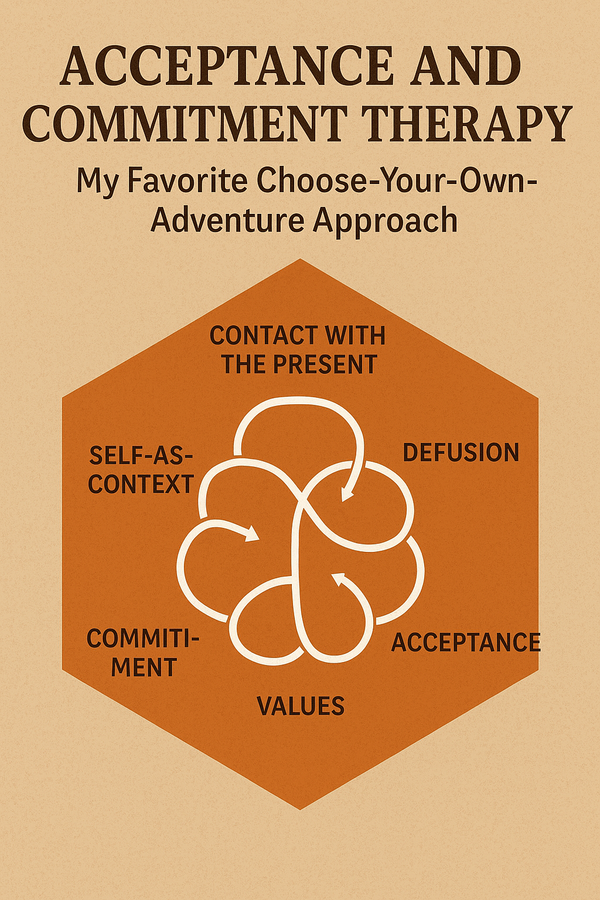Stuck in the “Should I / Shouldn’t I?” Spiral? Here’s a Way Through Everyday Decisions

Sometimes the decisions that take up the most mental energy aren’t the biggest ones.
They’re the “Should I go to the thing?”
“Do I say yes or no to this invite?”
“Do I spend the money, or stay home?”
“Do I rest, or push myself to show up?”
These are everyday choices, but they can still stir up anxiety, guilt, fear of missing out, people-pleasing, or self-judgment. And when your mind starts running in circles trying to figure out the perfect answer, even small decisions can start to feel heavy.
This is a gentle, values-based process I often use with therapy clients who are feeling stuck. It’s adapted from Acceptance and Commitment Therapy (ACT), which helps us make decisions not by chasing certainty, but by tuning in to what matters.
This isn't about optimizing or fixing. It's about choosing with care, from where you are right now.
🎢Step 1: It’s Okay That This Feels Hard
Not every decision has to be “big” to bring up tension. If you're feeling overwhelmed or unsure, that’s not a sign you’re doing it wrong — it’s just a sign you care, and you're trying to navigate conflicting needs.
So take a breath. No perfect answer required.
✍️Step 2: Zoom Out With a Quick Check-In
Try a fast cost-benefit reflection. You can jot this down in your notes app, say it out loud, or write it out by hand:
- If I go...
- Pros:
- Cons:
- If I don’t go...
- Pros:
- Cons:
This helps get the noise out of your head and onto paper, where it’s easier to sort through.
You might also ask: Is there more information I need? Sometimes the best next step is just asking a friend what time the event actually ends or checking if it’s refundable. Small facts can bring clarity.
🗣️Step 3: Name the Story
Notice what your mind is telling you. Maybe it’s:
- “If I skip this, I’ll regret it.”
- “If I go, I’ll feel drained and resentful.”
- “I should go. I always back out.”
- “I never let myself have fun.”
Whatever it is, see if you can gently name the pattern:
“Oh hey, there’s my ‘people-pleaser panic’ story.”
“There’s the ‘something bad will happen if I say no’ story.”
Naming it isn’t about pushing it away. It’s about seeing it more clearly, so you can choose how to respond.
💫Step 4: Check In With Your Values
Ask yourself:
What matters to me in this moment or this season of life?
Maybe it’s rest. Connection. Spontaneity. Boundaries. Creativity. Autonomy.
Whatever values show up, let them guide the choice.
You can also ask:
What do I want more of lately — and does this choice support that, even a little?
📅Step 5: Make a Choice for Right Now
You don’t need to decide forever. Try something like:
- “For today, I’m choosing not to go.”
- “I’ll wait 24 hours before deciding.”
- “I’m saying yes for now, and I can always reevaluate.”
Even choosing not to choose yet is still a choice. And that’s okay.
🪩Step 6: Take a Stand in the Choice You Make
Whatever you choose, ask:
How do I want to show up in that decision?
If you go, maybe you want to bring curiosity or openness.
If you stay home, maybe you want to honor rest or solitude.
Let your values shape not just what you choose, but how you show up in it.
💗Step 7: Be Kind to Yourself
There’s no perfect version of this. You’re allowed to have mixed feelings. You’re allowed to change your mind. You’re allowed to make a decision and still feel uncertain about it.
That doesn’t mean you’re broken — it means you’re human.
Talk to yourself the way you’d talk to a friend.
You can even say:
“I’m doing the best I can with what I know right now. That’s enough.”
The Bottom Line
This kind of decision-making isn’t about “figuring it all out." It’s about learning to move through the messy middle with more care, more self-trust, and a little less mental fog.
You can return to this process anytime something small starts feeling way bigger than it seems. It’s not just about what you decide; it’s about how you hold yourself through it.
🖤Kas




